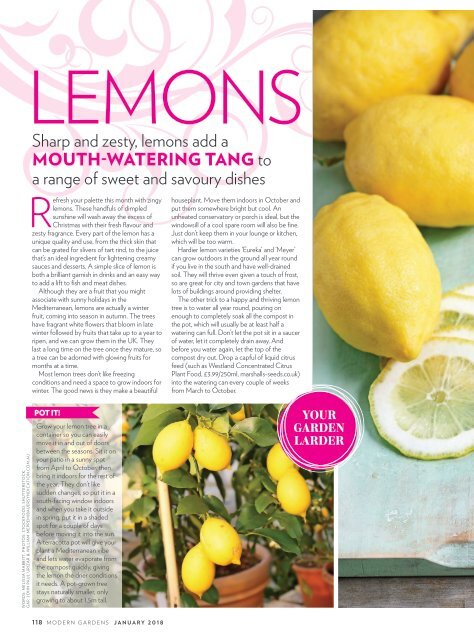You also want an ePaper? Increase the reach of your titles
YUMPU automatically turns print PDFs into web optimized ePapers that Google loves.
LEMONS<br />
Sharp and zesty, lemons add a<br />
MOUTH-WATERING TANG to<br />
a range of sweet and savoury dishes<br />
WORDS: MELISSA MABBITT. PHOTOS: STOCKFOOD, SHUTTERSTOCK,<br />
GAP, JOHN PAUL URIZAR & WILLIAM MEPPEM/BAUERSYNDICATION.COM.AU<br />
Refresh your palette this month with zingy<br />
lemons. These handfuls of dimpled<br />
sunshine will wash away the excess of<br />
Christmas with their fresh flavour and<br />
zesty fragrance. Every part of the lemon has a<br />
unique quality and use, from the thick skin that<br />
can be grated for slivers of tart rind, to the juice<br />
that’s an ideal ingredient for lightening creamy<br />
sauces and desserts. A simple slice of lemon is<br />
both a brilliant garnish in drinks and an easy way<br />
to add a lift to fish and meat dishes.<br />
Although they are a fruit that you might<br />
associate with sunny holidays in the<br />
Mediterranean, lemons are actually a winter<br />
fruit, coming into season in autumn. The trees<br />
have fragrant white flowers that bloom in late<br />
winter followed by fruits that take up to a year to<br />
ripen, and we can grow them in the UK. They<br />
last a long time on the tree once they mature, so<br />
a tree can be adorned with glowing fruits for<br />
months at a time.<br />
Most lemon trees don’t like freezing<br />
conditions and need a space to grow indoors for<br />
winter. The good news is they make a beautiful<br />
POT IT!<br />
Grow your lemon tree in a<br />
container so you can easily<br />
move it in and out of doors<br />
between the seasons. Sit it on<br />
your patio in a sunny spot<br />
from April to October, then<br />
bring it indoors for the rest of<br />
the year. They don’t like<br />
sudden changes, so put it in a<br />
south-facing window indoors<br />
and when you take it outside<br />
in spring, put it in a shaded<br />
spot for a couple of days<br />
before moving it into the sun.<br />
A terracotta pot will give your<br />
plant a Mediterranean vibe<br />
and lets water evaporate from<br />
the compost quickly, giving<br />
the lemon the drier conditions<br />
it needs. A pot-grown tree<br />
stays naturally smaller, only<br />
growing to about 1.5m tall.<br />
houseplant. Move them indoors in October and<br />
put them somewhere bright but cool. An<br />
unheated conservatory or porch is ideal, but the<br />
windowsill of a cool spare room will also be fine.<br />
Just don’t keep them in your lounge or kitchen,<br />
which will be too warm.<br />
Hardier lemon varieties ‘Eureka’ and ‘Meyer’<br />
can grow outdoors in the ground all year round<br />
if you live in the south and have well-drained<br />
soil. They will thrive even given a touch of frost,<br />
so are great for city and town gardens that have<br />
lots of buildings around providing shelter.<br />
The other trick to a happy and thriving lemon<br />
tree is to water all year round, pouring on<br />
enough to completely soak all the compost in<br />
the pot, which will usually be at least half a<br />
watering can full. Don’t let the pot sit in a saucer<br />
of water, let it completely drain away. And<br />
before you water again, let the top of the<br />
compost dry out. Drop a capful of liquid citrus<br />
feed (such as Westland Concentrated Citrus<br />
Plant Food, £3.99/250ml, marshalls-seeds.co.uk)<br />
into the watering can every couple of weeks<br />
from March to October.<br />
1YOUR<br />
GARDEN<br />
LARDER<br />
118 MODERN GARDENS JANUARY 2018

















